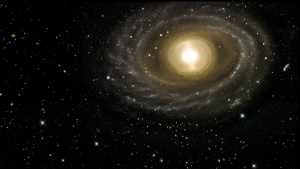Sep 4 2013
For hundreds of nights during the next five years, the world’s most powerful digital camera will turn skyward, helping a team of physicists and astronomers from around the globe answer fundamental questions about our universe.
 This image of the NGC 1398 galaxy was taken with the Dark Energy Camera. Credit: Dark Energy Survey
This image of the NGC 1398 galaxy was taken with the Dark Energy Camera. Credit: Dark Energy Survey
Astronomers from the University of Pennsylvania are playing an integral role in this team and its mission, a project known as the Dark Energy Survey. The project officially began on Aug. 31, the culmination of 10 years of planning, building and testing by scientists from 25 institutions in six countries.
“Preparing for this day has been a long road, but the road ahead is even more exciting,” said Bhuvnesh Jain, professor in the School of Arts and Sciences’ Department of Physics and Astronomy and leader of the Penn contingent. “We’re very much looking forward to seeing our first data. Every week images of several million distant galaxies will be recorded by our camera and processed by our software. The cumulative analysis of a full season of data will lead to novel results in multiple branches of cosmology.”
Other members of the team include department chair Larry Gladney, professor Gary Bernstein, associate professor Masao Sako and research-staff member Mike Jarvis.
The survey will systematically map one-eighth of the sky in unprecedented detail, with the goal of finding out why the expansion of the universe is speeding up, instead of slowing down due to gravity. They will probe the mystery of dark energy, the force believed to be causing that acceleration.
“With the start of the survey, the work of more than 200 collaborators is coming to fruition,” said DES Director Josh Frieman of the U.S. Department of Energy’s Fermi National Accelerator Laboratory. “It’s an exciting time in cosmology, when we can use observations of the distant universe to tell us about the fundamental nature of matter, energy, space and time.”
The main tool of the survey is the Dark Energy Camera, a 570-megapixel digital camera built at Fermilab in Batavia, Ill., and mounted on the 4-meter Victor M. Blanco telescope at the National Science Foundation’s Cerro Tololo Inter-American Observatory in the Andes Mountains in Chile. The camera includes five precisely shaped lenses, the largest nearly a yard across, that together provide sharp images over its entire field of view.
The Dark Energy Camera is the most powerful survey instrument of its kind, able to see light from more than 100,000 galaxies up to 8 billion light years away in each snapshot.
As co-leader of the Survey’s science verification team, Bernstein has spent much of the last year fine-tuning this instrument, aligning the car-sized camera to tolerances thinner than a human hair. The Survey’s science verification and data management groups have also prepared software to collect and measure the nearly one terabyte of image data that will be produced every night of the survey — far more than the scientists could ever examine by eye.
During the five years, the survey will obtain color images of 300 million galaxies and 100,000 galaxy clusters and will discover 4,000 new supernovae, many of which were formed when the universe was half its current size. These observations will not be able to see dark energy directly, but, by studying the expansion of the universe and the growth of large-scale structure over time, the survey will give scientists the most precise measurements to date of the its properties.
The survey will use four methods to probe dark energy: counting galaxy clusters, measuring supernovae, studying the bending of light through a technique known as gravitational lensing and analyzing patterns in the distribution of galaxies.
Jain is the co-coordinator of the gravitational lensing group. Lensing is a phenomenon in which light from distant galaxies is bent by the gravity of massive objects on its way to Earth. When light from distant galaxies encounters dark matter in space, it bends around the matter, causing those galaxies to appear distorted in telescope images.
Jain, Bernstein, Jarvis and their colleagues from around the world will compare hundreds of thousands of galaxies, looking for patterns in such distortions that would reveal dark energy at work. Jarvis is in charge of the Survey’s “lensing pipeline.” His work will reduce each of the galaxies imaged with the Dark Energy Camera to their vital stats via computer algorithms, so they can be more easily compared.
Sako is the co-coordinator of the supernovae group. As part of this team, Sako and Gladney will hunt for new stellar explosions and enlist the help of other telescopes to triangulate their positions, providing additional data about their home galaxies’ distance and motion. The massive scope of the Survey will enable the researchers to observe these relatively rare phenomena more regularly, but they will still have to act quickly to record data from the events before they fade from the sky.
The data collected will be processed at the National Center for Supercomputing Applications at the University of Illinois in Urbana and then delivered to collaboration scientists and the public.
The Dark Energy Survey is supported by funding from the U.S. Department of Energy Office of Science; the National Science Foundation; funding agencies in the United Kingdom, Spain, Brazil, Germany and Switzerland; and the participating institutions.
More information about the Dark Energy Survey, including the list of participating institutions, is available at www.darkenergysurvey.org.